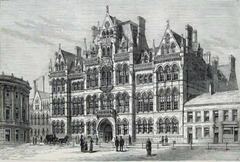Status Demolished Construction started 23 February 1875 Demolished 1964 Cost 60,000 GBP | Opened 1 October 1880 Floor count 4 Architectural style Gothic architecture | |
 | ||
Mason Science College was a university college in Birmingham, England, and a predecessor college of Birmingham University. Founded in 1875 by industrialist and philanthropist Sir Josiah Mason, the college was incorporated into the University of Birmingham in 1900. Two students of the college, Neville Chamberlain and Stanley Baldwin, later went on to become Prime Ministers of the UK.
Contents
History
The college was established by an English industrialist and philanthropist Sir Josiah Mason in 1875. The building of the college in Edmund Street, Birmingham was designed by Jethro Cossins and opened on 1 October 1880 and was marked by a speech by Thomas Henry Huxley. In the speech, Huxley considered the opening of the college as a victory for scientific cause and supported Mason's antagonistic views on the classics and theology. The college developed various liberal and vocational subjects, but forced out the artisans. The medical and scientific departments of Queen's College, Birmingham moved to the nearby Mason Science College.
In 1898 it became Mason University College, with Joseph Chamberlain becoming the President of Court of Governors of the college. In 1900 it was incorporated into the University of Birmingham. Students at the College were awarded their degrees by the University of London until the University of Birmingham was established and received degree awarding powers in its own right.
William A. Tilden was professor of chemistry from 1880 to 1894. In September 1893 Francis William Aston began his university studies at the college, where he was taught physics by John Henry Poynting and chemistry by Frankland and Tilden.
In 1881 Charles Lapworth became the first professor of geology at the college. In 1891 physics professor John Henry Poynting successfully calculate the mean density of the Earth.
The Mason College building housed Birmingham University's Faculties of Arts and Law for over half a century after the founding of the University in 1900. The Faculty of Arts building on the Edgbaston campus was not constructed until 1959-61. The Faculties of Arts and Law then moved to the Edgbaston Campus.
The original Victorian neo-gothic building was demolished in 1964, along with the original Central Public Library and the Birmingham and Midland Institute, as part of the redevelopment within the inner ring road. The former Central Library stood on the site of the old college, the library having moved to a new site in 2013; the building is being demolished (2015).
Departments
During the first academic session of the college in 1880 courses in physics, chemistry, biology and mathematics were offered to students. By 1881 courses in geology and mineralogy, botany and vegetable physiology, engineering, English language and literature, Greek and Latin, and French and German language and literature were also available. From 1882 Medical students at Queen's College, Birmingham were able to attend classes in botany, physiology and chemistry, and in 1892 the medical faculty of Queen's College was transferred to Mason College. There was also a short-lived department of ‘Mental and Moral Science’, which was not successful despite funds being gifted specifically to support the endeavor in 1882.
Academics and alumni
Notable academics and alumni of the college include:
